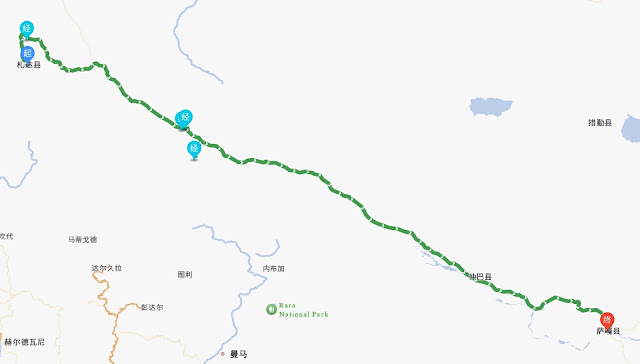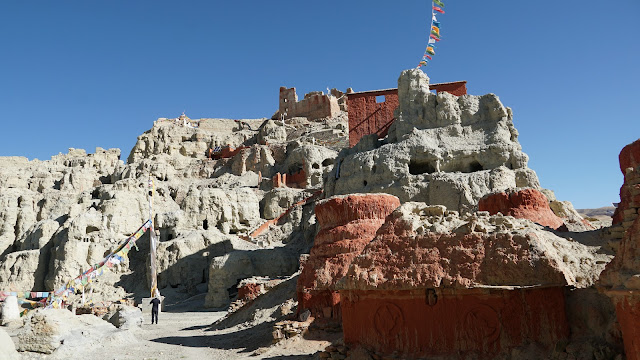Tibet: Ngari Prefecture - Donggar and Piyang Caves, Lake Manasarovar, Chiu Monastery
By Cubie - July 19, 2025
 |
| Map from Gaode: Dark blue - start, red - end |
Day 1
Start: Zanda 札达县
1. Donggar & Piyang Caves 皮央和东嘎遗址
2. Gang Rinpoche Base Camp 冈仁波齐大本营
End: 3. Darchen 塔钦
Day 2
Start: Darchen 塔钦
4. Lake Manasarovar 玛旁雍措
5. Chiu Monastery (very near Lake Manasarovar)
End: Saga 萨嘎县
Donggar & Piyang Caves 皮央和东嘎遗址
The most important monastic communities in Guge were at Tholing and Tabo (in Ladakh) but extensive cave paintings discovered in the early 1900s suggest others were of great significance as well. The wall painting at remote Dungkar from the 12th century are possibly the oldest in Ngari. The cave mural style had influence of Kashmiri-Central Asia, this ties them with the Silk Road mural of Kizil in China.
There are three main caves in a side valley in Donggar, the best preserved is the mandala cave. A few kilometres away is the village of Piyang. It lies at the foot of a large ridge honeycombed with thousands of caves. The top has a ruined monastery and two caves with fine murals. Both Donggar and Piyang caves are looked after by a caretaker.
 |
| Piyang |
 |
| Earth forest view from Piyang |
 |
| Donggar |
Gang Rinpoche Base Camp 冈仁波齐大本营
This was a very, very, very windy lookout point for Gang Rinpoche (Mt Kailash). We stopped for toilet break before reaching Darchen.
Lake Manasarovar 玛旁雍措
Lake Manasarovar or Mapam Yumtso (in Tibetan) or Mapang yong cuo (in Chinese) is one of the holy lake in Tibet. It is a sacred site for Hinduism, Buddhism, Jainism, and Bon.
In Hinduism, it is believed that Lord Brahma created the lake to provide a divine bathing place for his sons after their journey. Buddhists revere it as the site where the Buddha's mother was brought by the gods to bathe. In Jainism, the lake is linked to the first Tirthankara, who attained nirvana in the Himalayas. As for Bon, it is often seen as the palace of dragons.
Lake Manasarovar has been circumambulated by Indian pilgrims since at least 1700 years ago. Based on Hindu interpretation, it was said that manas refers to the mind of the supreme god Brahma and the lake being its outward manifestation. So Indian pilgrims believe in bhating in the waters of the lake and kora around its shoreline. That said, swimming is forbidden at the lake, so it was said that water were taken from the lake for bathing.
We visited the lake first, and then visited the nearly Chiu Monastery.
 |
| Lake Manasarovar and Chiu Monastery |
Chiu Monastery
"Chiu" means a sparrow. Chiu Monastery is closely related to Guru Rinpoche (Padma Sambhava). In the 8th century, when Guru Rinpoche was looking for a place for medications, a Dakini manifested as a sparrow and flew into a cave. Guru Rinpoche decided to meditate in the said cave for a week, and the monastery is named Chiu Monastery. It was also said that Guru Rinpoche spent the last seven days of his life in the cave.
Inside the monastery, one can get sacred items to put inside a Buddha status. The guide got some earth, from memory the earth was from Manasarovar. I remembered there were also dried fish from the lake that was said to have healing properties, and water from the lake in a spray bottle.
Side note: Game updated!





0 comments